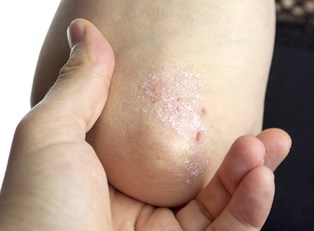Plaque psoriasis is an uncomfortable condition that leads to large patches of dead cells on the skin’s surface, known as plaque. These patches are typically white, itchy, and prone to flaking off over time. This condition stems from an immune system disorder in which a person’s T cells (a form of white blood cell) attack and kill his or her healthy skin cells, which leads to the accumulation of plaque.
Most treatments revolve around both stopping the immune system response to skin cells and treating breakouts that have already begun. Here is a look at three of the most common ways this is accomplished: topical products, medication, and phototherapy.
Topical Products
Topical creams and ointments are two of the most common ways that people treat their plaque psoriasis. These include corticosteroids, salicylic acid, anthralin, and even coal tar. Some topical products can be purchased over-the-counter, but the particularly powerful ones normally require a prescription.
Corticosteroids have anti-inflammatory properties that help suppress a person’s immune system, which in turn slows the rate of new skin cell growth. This type of drug can be very powerful, so most doctors warn patients to exercise caution when using them on sensitive areas of the body, such as the face. Additionally, corticosteroids lose their effectiveness over time, so it’s recommended that they only be used on active plaque breakouts.
Salicylic acid is available in both over-the-counter and prescription strength. This product does not slow the rate of skin cell growth, but it has been shown to be effective at sloughing off dead skin cells that have already accumulated.
Like corticosteroids, anthralin helps slow down the production of skin cells. However, it’s much more powerful and stains everything it touches, so most doctors recommend only using it for very short periods of time. Anthralin is seen more as a last resort to fighting psoriasis when other treatments have not been effective.
Coal tar, a byproduct of the coal refining process, is one of the oldest treatments used for fighting plaque psoriasis. This black, sticky substance helps remove dead skin cells and reduces itching, but researchers are still not entirely sure why it works. Despite being such an effective plaque psoriasis treatment, some people avoid coal tar because of its tendency to stain clothing and the health risks it poses to pregnant or breastfeeding women.
Medication
For intense cases of plaque psoriasis, topical products may not be enough. Oral or injected medications are a more common form of severe plaque psoriasis treatment. However, these medications are extremely powerful and sometimes come with significant side effects, meaning they are typically used sparingly.
Retinoids, which are a chemical compound related to vitamin A, can help reduce the number of skin cells a person’s body produces and are a common choice for treatment when other remedies have failed. Their side effects include lip swelling, hair loss, and birth defects in pregnant women, but these effects dissipate once a patient has stopped use.
Another popular medication choice is methotrexate. Like retinoids, it reduces the number of skin cells produced by the body, but it is generally better received by patients due to its milder side effects. They include only nausea, appetite loss, and fatigue. Side effects do not always occur, especially when the drug is taken in small doses.
Phototherapy
Phototherapy, or exposure to ultraviolet light, may be able to help with mild to moderate cases of plaque psoriasis by slowing the immune system’s response to skin cells, but it’s generally not as effective as topical products or medication. However, it can still act as a good supplement to these more conventional forms of plaque psoriasis treatment.
The easiest way for patients to receive UV exposure is simply by being outside. It’s important that these exposures be regular but brief, because large doses of UV rays can actually make the condition worse.
If regular exposure outside is not an option, patients may also purchase a UV lamp for plaque psoriasis treatment indoors. These are relatively inexpensive and come in a variety of shapes and sizes depending on a patient’s own personal preferences. Like exposure to sunlight, UV lamp use should be regular but brief.



